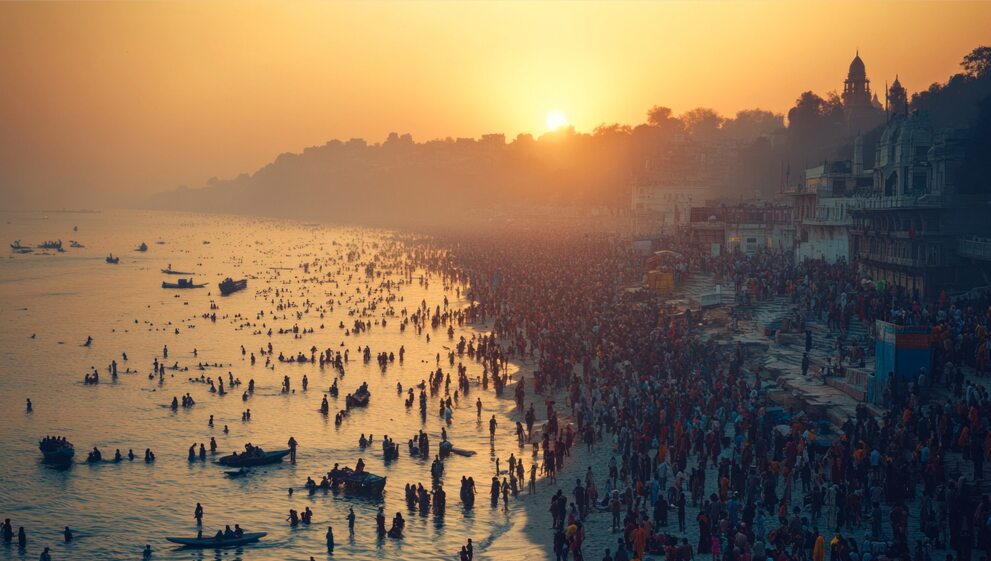The Kumbh Mela isn’t just a festival; it’s a journey of the soul! Here’s your guide to the top experiences and how to find your way to them. Whether you’re taking a holy dip or savoring local food, we’ve got the exact details to make your trip smooth and memorable.
1. Take a Dip in the Holy Rivers
Where: The Sangam, Prayagraj (the confluence of the Ganga, Yamuna, and Saraswati rivers).
When:
a). Paush Purnima on January 13, 2025 marks the beginning of the Kumbh Mela; an important day for taking a holy dip.
b). Makar Sankranti on January 14, 2025 celebrates the sun’s transition into Capricorn; the first Royal Bath, attracting millions of devotees.
c). Mauni Amavasya on January 29, 2025 is considered the most auspicious day for bathing; devotees observe silence and take a holy dip.
d). Basant Panchami on February 3, 2025 marks the onset of spring; with devotees wearing yellow attire.
e). Maghi Purnima on February 12, 2025 witnesses a full moon day; bathing on this day is believed to bring spiritual benefits.
f). Maha Shivratri on February 26, 2025 is dedicated to Lord Shiva; marks the conclusion of the Kumbh Mela with a holy dip. Participating in the holy dip on these dates is believed to cleanse one’s sins and lead to spiritual liberation.
How to Get There:
Use the official Kumbh Mela app or website for directions and crowd updates. Taxis, auto-rickshaws, and shuttle buses are available from major city points like Prayagraj Junction or Civil Lines.
Who to Contact:
1). Local Authorities: Visit the help desks set up near the ghats.
2). Helpline Numbers: Dial the Kumbh Mela Helpline for real-time assistance.
2. Cultural Performances and Spiritual Discourses
Where: Main cultural pavilions, typically located near key bathing ghats and akhada zones.
How to Get There:
Check the Kumbh Mela daily schedule on the official website or app for event locations and timings. Walk or use e-rickshaws for short distances within the Mela grounds.
Who to Contact:
Ask for information at the nearest tourist kiosk. Volunteers in yellow jackets can guide you to the cultural zones.
3. Visit Akhada Camps
Where: Akhada zones are set up across the Mela area, often divided by sects (Shaiva, Vaishnava, etc.).
How to Get There:
Maps of the akhada zones are available online and at the Mela information centers. Follow signboards or ask volunteers for directions.
Who to Contact:
Approach the Kumbh Mela Information Center for details on visiting schedules and interactions.
Most akhadas welcome visitors during specified hours, so confirm timings beforehand.
4. Savor Traditional Cuisine
Where: Food courts and stalls near the cultural zones and main bathing ghats.
How to Get There:
Food zones are marked on the Kumbh Mela map, available at information centers and the app. Use local transport like e-rickshaws or simply explore on foot.
Who to Contact:
Look for food stalls with a “Certified Hygiene” badge issued by the Kumbh Mela organizers. Contact food safety volunteers patrolling the area for guidance.
5. Explore Ancient Temples
Where: Prominent temples like Bade Hanuman Mandir, Akshaya Vat, and Allahabad Fort.
How to Get There:
Hire a local guide or use GPS to navigate from the Mela grounds. Shuttle buses run from key ghats to nearby temples.
Who to Contact:
Local temple authorities or guides available near the temple premises. Use the Kumbh Mela app to locate less crowded timings for your visit.
Pro Tip: Contact and Planning Made Easy
1. Official Kumbh Mela Helpline
Call: 05322504011,
Email: info.mahakumbh25@gmail.com
2. Download the Official Kumbh Mela App:
Available on Android and iOS, the app provides real-time updates on routes, events, and safety tips.
3. AntiFraud.AI App:
For secure digital transactions and fraud prevention, AntiFraud.AI for UPI and online bookings keeping one digitally safe while enjoying the free subscription via (Maha Kumbh Mela landing page link)
By planning ahead and knowing where to go, your Kumbh Mela experience will be stress-free and full of unforgettable moments. Happy exploring!


